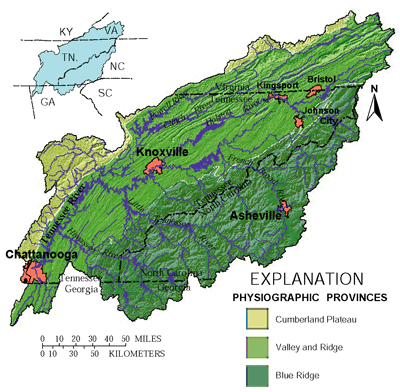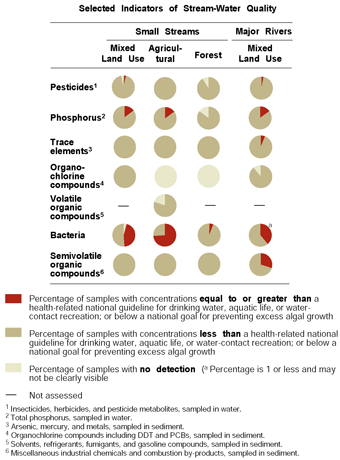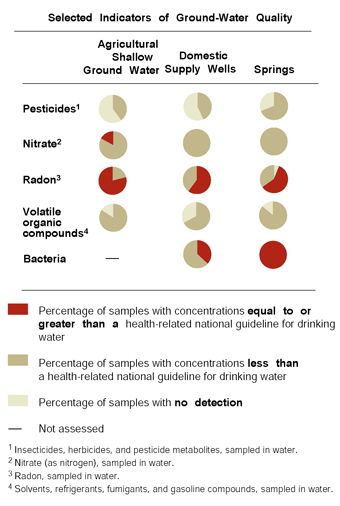SUMMARY OF MAJOR FINDINGS
 |
| The Upper Tennessee River Basin encompasses about 21,390 square miles and includes parts of four States: Tennessee, North Carolina, Virginia, and Georgia. Three major physiographic provinces are represented in the basin: the Cumberland Plateau, Valley and Ridge, and Blue Ridge Provinces. Most of the 2.4 million people residing in the basin live in the four metropolitan areas of Knoxville and Chattanooga, Tennessee; Asheville, North Carolina; and the Tri-Cities area of Tennessee and Virginia. |
The Upper Tennessee River Basin is characterized by an abundance of surface water that usually meets existing guidelines for drinking-water supply, recreation, and the protection of aquatic life. Bacteria levels, however, frequently exceed State standards for contact recreation both in agricultural and urban areas. In addition, mixtures of pesticides were detected at 67 of the 74 stream sites sampled. No pesticide concentrations exceeded drinking-water standards, but standards have not been determined for 11 of the 31 compounds detected.
- Bacteria levels frequently exceeded State standards in agricultural streams and streams in urban areas. Runoff from pasture land and direct livestock access to streams contribute to elevated bacterial counts in agricultural streams. Aging wastewater infrastructures are the most likely cause of elevated bacteria counts in urban streams.
-
Inputs from urban and agricultural land uses have increased nutrient levels in streams. Yields of total nitrogen in streams are correlated to agricultural inputs, such as animal waste and fertilizer applications, whereas yields of total phosphorus are correlated with wastewater discharges. Tributary reservoirs serve as effective sinks for both nitrogen and phosphorus species in the basin.
- Herbicides and herbicide degradates were detected in 98 percent of the 428 total stream-water samples collected but at levels within drinking-water standards and aquatic-life guidelines. Insecticides used on agricultural fields, gardens, and lawns were detected infrequently (less than 12 percent of samples) and were at levels within drinking-water standards. Concentrations exceeding aquatic-life guidelines were observed, however, for carbaryl, diazinon, and lindane.
- Contamination from previous industrial and mining activities persists in parts of the basin resulting in fish-consumption advisories for PCB’s (polychlorinated biphenyls), dioxin, and mercury in certain reservoirs and stream reaches. SVOC (semivolatile organic compounds) sediment concentrations exceeding aquatic-life guidelines were detected in some stream reaches draining coal mining areas.
- The Upper Tennessee River Basin is widely known for its aquatic diversity of fish and mussel species. While mussel populations are recovering in some parts of the basin, overall diversity is slowly declining.
- Releases and spills resulting in fish and mussel kills have occurred in many parts of the basin and pose a threat to isolated and endangered populations of aquatic species.
Trends in Stream-Water Quality
Because of water-treatment improvements, nitrogen and phosphorus levels for most of the streams in the Upper Tennessee River Basin remained unchanged or decreased from 1970 to 1993. Nitrogen concentrations, however, increased significantly for many streams in the Blue Ridge physiographic province because of nonurban residential development and aquaculture.
Trends in other water-quality constituents are difficult to assess because of changes in data-collection methods over time and an overall lack of data. Persistent organochlorine compounds such as DDE, a breakdown product of DDT, which was discontinued in 1973, and chlordane, which was discontinued in 1988, are still detected in fish tissues and bottom sediments in various parts of the basin.
| Major Influences on Surface Waters
|
Although ground-water use accounts for a little more than 3 percent of the total water use in the basin, over one-third of the population relies upon ground-water sources for drinking water. In the Upper Tennessee River Basin, ground-water studies focused on the carbonate rock formations of the Valley and Ridge physiographic province, which compose the most prolific aquifers in the basin and are the most susceptible to contamination. These aquifers typically provide water that meets all Federal and State drinking-water standards with the exceptions of nitrate and bacteria. Nitrate concentrations in domestic wells and springs used as drinking-water sources were within drinking-water standards and guidelines. Levels of nitrate exceeding drinking-water standards were detected only in shallow agricultural monitoring wells. Numerous pesticides and volatile organic compounds were detected in wells and springs, but none exceeded drinking-water standards.
- Bacteria levels exceeding finished drinking-water standards were detected in 11 of 30 wells used for untreated domestic drinking-water supply and in all 35 springs sampled. Bacteria levels in two springs exceeded State standards for recreation. Seventeen of the springs sampled are used for untreated drinking-water supplies.
-
Nitrate was present in all domestic wells and springs but usually in concentrations well within the Federal drinking-water standard. Five of 30 monitoring wells that were installed adjacent to burley tobacco fields contained nitrate concentrations exceeding the drinking-water standard.
- Pesticides were detected in 40 percent of the agricultural wells, 43 percent of domestic water-supply wells, and 69 percent of the springs in relatively low concentrations. No pesticide concentrations exceeded drinking-water standards; however, 5 of the 18 compounds detected currently do not have standards. The most frequently detected pesticides were atrazine and metalaxyl (tobacco-specific) in the agricultural wells and atrazine, tebuthiuron, and prometon in domestic wells and springs.
- Volatile organic compounds were detected in 86 percent of the springs and 67 percent of the domestic wells sampled. Trichloromethane was the most frequently detected compound of the 28 volatile organic compounds that were detected; but carbon disulfide, propanone, and methylbenzene generally were detected in the highest concentrations. None of the volatile organic compounds exceeded drinking-water standards or guidelines, but only 12 of the 28 currently have standards.
| Major Influences on Ground Water
|
| Table of Contents || Previous Section || Next Section || Glossary U.S. Geological Survey Circular 1205 Suggested citation:
|

